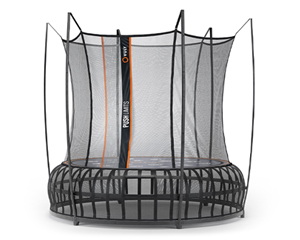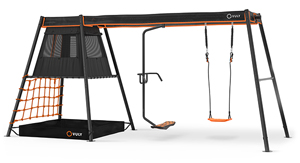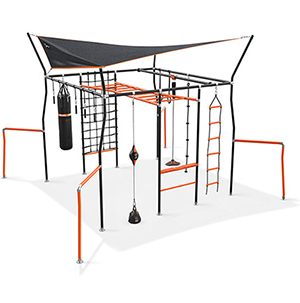
Trampoline safety is very important.
Vuly Play are exemplars of trampoline safety. We pride ourselves on our safe trampoline models, ensuring every bounce is the safest it can be.
Despite this, injuries can still occur, especially if proper safety guidelines are ignored.
According to the Australian Competition and Consumer Commission (ACCC), a survey conducted by Kidsafe WA on their behalf identified a range of unsafe practices that could put children at risk.
Such was the concern, the ACCC teamed up with Vuly Play Hero and Olympic trampolinist Blake Gaudry to spread awareness.
The study also highlighted a large discrepancy between the safety guidelines and the actual usage of trampolines.
This means that trampolines aren't necessarily unsafe – especially with the advanced safety considerations of modern trampolines – but users should be aware of the risks involved while trampolining.
So are trampolines safe?
Yes, trampolines are safe – when following Vuly’s top tips for an injury-free trampolining experience for you and your family.

Trampoline Safety Guidelines
Trampoline for kids is highly beneficial, but care should be taken to reduce round trampoline safety risks.
Usually, accidents are a result of jumpers' negligence, poor judgment, or disregard for safety rules.
Vuly strives to educate users on the common safety mistakes that users make.
By adhering to the simple safety measures below, you can prevent most injuries before they happen.
One Jumper at a Time
Vuly recommends that there should be no more than one person on a trampoline at any time. This is a major trampoline safety risk.
Multiple jumpers increase the chances of injury while bouncing, as they are unable to judge the dynamics of the jumping motion, putting all users at an increased risk of injury.
Additional users also introduce unknown variables in the rebounding motion and can lead to unintentional falls.
Every movement made by an additional user sends forces through the jump-mat. These forces upset the rhythm and the balance of other people jumping.
These back-and-forth exchanges of energies through the mat can range from subtle disruptions to larger uncontrollable disturbances.
This can lead to someone falling down awkwardly or into the other person bouncing.
One trampoline user falling on another is a leading cause of broken bones in trampoline injuries
Because of these points, children should take turns wherever possible.
Safe Trampoline Location
Every trampoline owner should be using their trampoline in a safe environment.
You should ensure the area around your trampoline (ideally 1m-2m wide on all sides) is free from any hazards, such as walls, play equipment, or garden furniture.
There is also a minimum clearance of 8m overhead from the ground level to avoid objects like clotheslines, trees, and wires.
It’s ideal that the clearance area around your trampoline is thickly layered with soft, impact-absorbing material, e.g. pine bark, wood chips, or sand.
This should be regularly racked to reduce compacting.
Supervise
Supervision can usually prevent most trampoline injuries that are caused by risky behaviour.
Children and inexperienced jumpers should always be supervised.
Remember, younger kids are more likely to use poor judgment and put themselves in danger when they are not under the supervised direction of a responsible adult.
It’s also a good idea to encourage older children to take responsibility for the younger ones, and to consistently enforce ‘safe bouncing’ rules.

Trampoline Safety - Best Practices
When using a Vuly trampoline, it’s very important the following best practices are adhered to avoid injury.
add Never Go Underneath
Do not allow any individuals beneath the trampoline at any time.
Individuals who do not observe this rule risk receiving head injuries from the person jumping above.
Additionally, individuals who are under the trampoline can also get their fingers, skin, or hair caught in the springs.
add Getting In and Out
As our trampolines feature a doorway in the safety netting, many users become confused as to the proper way to dismount.
Many users make the mistake of crawling through the door head-first.
However, dismounting this way requires the user to rotate their body as they exit so their feet can be firmly placed on the ground.
Hands, feet, or other body parts can cause the user to get caught in the net and fall to the ground head-first.
The easier, safer way to dismount our safety netted trampoline is to move to the door, sit down, and then slide out feet-first.
This movement makes certain that feet are the first thing that contacts with the ground and eliminates the risk of becoming entangled in the net.
If accessing the trampoline proves to be challenging, we recommend purchasing a trampoline ladder.
Some families use concrete blocks, bricks, or cardboard boxes to make mounting the trampoline easier.
However, these materials can easily shift, making the structure unstable.
Our ladders feature two extra-wide no-slip steps to assist users trying to access the trampoline.
They hook sturdily to the trampoline underneath the safety padding, eliminating the risk of shifting.
add Be Careful of Advanced Tricks
There’s a reason that gymnasts train for years before they attempt advanced tricks!
Not only do they require developed strength and flexibility, but they can also result in serious injury if not done correctly.
Somersaults or flips require proper training before being performed. Younger or inexperienced users are better off sticking with simple bouncing.
add Be Wary of Muscle Fatigue
Trampolining is a great way to sculpt the legs, arms, and torso.
As it’s such a fun exercise method, some bouncers may not realise how long they have been working out.
Trampoliners should always be aware of muscle fatigue or failure.
Jumping on a trampoline requires short bursts of energy and strength to rebound into the air.
As a result, many users may be deceived into thinking that they have much more strength and stamina than they possess.
Fatigued legs may not feel weak until the user tries to resume normal activity, like climbing down the trampoline ladder or walking.
Trampoline enthusiasts need to exercise caution when walking, climbing stairs, approaching slopes, or dismounting the trampoline to avoid tripping or collapsing.
Muscle weakness generally dissipates quickly, but inexperienced jumpers may feel lingering aches and fatigue in the muscles for a few days after the jumping session.
Over time, muscles will become less prone to fatigue and the jumper can use the trampoline for longer periods of time without noticeable muscle weakness.
Consistent trampoline exercise has been linked:
- Toned muscles
- Improved cardio-respiratory performance
- Increased muscular stamina
- Lower cholesterol and weight loss
- Lower blood pressure
- Improved ocular-motor skills
- Increased flexibility
- Greater balance and spatial awareness
Tips For First Time Trampolinists
Some kids take to trampolines the instant they experience their first bounce, while others take a little bit of encouragement.
Here are a range of tips to help those exploring trampoline bouncing for the first time.
Finding Balance
Trampolines can be disorientating for some kids who have never stood on one before.
For this reason, start by helping them bounce on the spot by using their ankles to go up and down, but without their feet leaving the mat.
Next, let them get used to the trampoline springiness, and to the shifts in gravity while bouncing.
This can be achieved with a 'stop bounce', the first skill that anyone who uses a trampoline should learn.
The 'stop bounce' will allow you to regain control by quickly stopping your movement.
Practice it by stopping your bouncing with the act of bending your knees and hips when you land on the mat.
Continue by keeping your feet on the mat, absorbing the rebound of the trampoline through your knees and waist.
Keeping Eyes on the Edge
Pick a point on the side of the trampoline, and place a fluorescent sticker there.
Have the trampoliner focus their gaze on the side of the trampoline, where the stick is located.
Focusing on a point helps the user feel more steady and in control.
This is ideal when performing consistent and repeated exercises, and it's easy for kids to understand.
Your body likes to have a point of reference – give it one!
Practice Your Arm Movements

When the trampoliner is confident enough in their balance and control, they should practice their finer body movements.
Arms are key to maintaining control while bouncing. Whenever the jumper is in the air, their arms should be too.
Arms should be raised during each bounce – to about shoulder height and width.
This position should be kept until the jumper starts falling before they lower their arms slightly behind the hips.
The jumper then re-lifts their arms as they start the bouncing motion again.
People often think that trampolining is all about the legs when really it's your arms that do most of the work to stabilise you.
Checking Trampoline Assembly and Components
While Vuly trampolines are some of the easiest trampolines to assemble on the market, there's always the potential for error when putting together products containing individual parts.
Bouncing on an improperly assembled trampoline not only reduces its life but also represents a safety hazard to those using it.
Here are some of the more common assembly issues we see at Vuly.
Net Poles
Every correctly installed Vuly trampoline has an 'hourglass' enclosure.
This means that its net poles curve outwards while its netting curves inwards.
While you may have the urge to insert the net poles in a way that makes them 'straighter' – like a typical trampoline design – this is incorrect for a Vuly.

On all trampolines except Thunder Pro, this means that the net poles should bend away from the net at the top and curve back inwards at the jump mat – like an 'S'.
Thunder Pro net poles should have a totally convex appearance, with the peak of the curve away from the net being in the centre of the net poles – like a ‘)’.
If you're still unsure whether your net poles are inserted correctly based on appearance, the easiest ways to check are:
- Ensure that each installed net pole has small holes punched at the top (excluding Ultra) and middle of the Upper Net Pole and at the connection between the Upper and Lower Net Pole.
- Ensure that each Lower Net Pole is correctly inserted into the Joiner – with the reinforcing inside the tube at this end.

Joiner Poles
The feet on every Vuly trampoline face outwards (except Ultra, which has leg tubes – rather than feet – which bend inwards).
Installing your trampoline in such a way that the feet face inwards will flip your Joiner Poles that connect the entire frame and net together.
This reduces the integrity of the finished trampoline, may cause a distorted appearance or lead to other parts failing to connect correctly.
Always make sure that the small feet at the end of each frame leg face towards you.
ThunderBolts
Thunder is the only Vuly trampoline that requires bolts during installation.
Your assembly manual details how to use these bolts – rather than push-buttons – at the Joiner Poles, to strengthen your Thunder's base.
While it is possible to assemble your Thunder without these bolts, we strongly discourage it.
If you have a Thunder, check that you have used the bolts that came with your packaging at the Joiner Poles, as directed.
While you're inspecting your Thunder, make sure that your slimline net pole pads are positioned at the bottom of the net poles!
Checking Trampoline Components
Trampoline owners should regularly check the condition of their trampoline.
Some of the key components to check:
- The jump-mat and safety net does not have any rips or holes
- The springs are intact and securely attached at both ends
- The frame is not bent
- The leg braces are securely locked
Remove dust and dirt from the trampoline regularly as it can damage the materials in the padding and safety net.
By running a moist rag over the safety pads, netting, and other perishable parts of the trampoline, the lifespan of the materials dramatically increases.
It's also a smart idea to refresh your trampoline with spare parts, ensuring it stays in tip-top condition.
Trampoline Safety Risks & Pets
Our pets are often considered to be a part of the family.
But, even though your dog or cat goes everywhere you do a trampolines aren’t a great place for them to be.

Pets claws and teeth can damage both the safety net and jump-mat material that could lead to injury.
Worse, dogs and cats may wander underneath the jump mat while the trampoline is in use.
Sadly, there have been cases that have seen a distracted pet become injured by a person jumping above.
Don't let this happen to your pet by keeping a close eye on them when someone is using your trampoline.
Teach pets that the trampoline area is off-limits to them.
If necessary, leave them in a contained area (house, kennel, etc) while the trampoline is in use.
You can also Invest in a Vuly trampoline skirt to prevent pets from going underneath the trampoline and stop them from climbing up the net poles.
Sun Safety
We all want our kids to get outdoors and play in the sunshine, but in the summer months we have to be extra wary to make sure kids stay safe under the sun.

UV rays can be nasty, particularly in Australia, and especially in the middle of the day.
This is why it’s important to be 'SunSmart'.
Being sun smart is all about making the right choices around your activities while being outdoors.
This includes wearing a hat, putting on sunscreen, going out at times when the sun is not at its peak, and drinking plenty of water.
When it comes to children, we need to cover these points to make sure they stay sun safe while trampolining.
Sun Dangers
While you can never go wrong with the classic Australian ‘Slip, Slop, Slap’ rules, there are several things to keep an eye on during our hottest periods.
Sun Burn

One of the most common reasons to stay sun smart is to ward off the dreaded pain of sunburn.
You don’t just have to be sunbaking on the beach to get burnt. It can happen anywhere!
As long as the skin is exposed to UV light, there’s a chance that it could get burnt.
Sunburn is easy to spot. The skin will start turning red, it becomes warm to the touch, and sometimes it'll peel too.
Use an aloe vera lotion to soothe the burn and quicken the recovery.
To keep sunburn at bay, make sure that your kids wear hats and sunscreens if they'll be playing outdoors – particularly in summer.
Remember: SPF 30+ is always the best choice.
Dehydration
Dehydration occurs when a person doesn’t have enough fluids in their body.
In kids, this can happen much more easily than adults – when they’ve been running around in the sun, sweating, and not drinking enough water.
Make sure that your children are drinking plenty of water when playing outside.
The hotter it is, the more they will need to drink, so the body is well hydrated.
Some common symptoms to look out for include:
- Thirst
- Dry mouth, lips, and tongue
- Headaches
- Dizziness or light-headedness
Heat Stroke

Heatstroke is caused by your body overheating and can be a risk for any child playing outside in the heat for too long.
To prevent this, make sure children are taking rest breaks in the shade regularly throughout the day.
The higher the temperature, the more regularly they should seek out cover to ward off heatstroke.
Common heat stroke symptoms include:
- High body temperature
- Confusion, agitation, or irritability
- Hot skin that's dry to touch
- Flushed skin
- Nausea and vomiting
- Rapid breathing
- Racing heart rate
Sources
Australian Competition and Consumer Commission – www.accc.gov.au
Kids Safe WA – www.kidsafewa.com.au
SunSmart – www.sunsmart.com.au







































